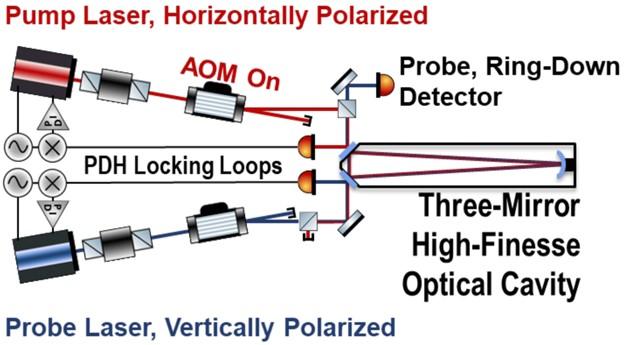Cavity Ring-Down Spectroscopy (CRDS) can be used to detect minute quantities of gaseous species in a gas sample by first introducing the sample into an optical cavity, typically between highly reflective mirrors. A pulse of laser light is then trapped in the gas-containing cavity, which will circulate between the mirrors, slowly decreasing in intensity as it gets absorbed (sample gets excited), scatters and leaks from the cavity. The ring-down (decay) time is measured and compared to the baseline decay time when there is no sample in the cavity; results can be used to calculate the concentration of the gaseous species. One of the drawbacks of CRDS involves baseline variations which limits sensitivity and accuracy. LLNL researchers have been able to develop a novel two photon, two color cavity (2P3C) ring down spectroscopic method that can overcome this challenge, providing high sensitivity even under non-ideal experimental conditions.
LLNL’s novel approach combines 2-color spectroscopy with CRDS, a combination not previously utilized. This second-generation CRDS system is comprised of two light sources (a “pump” laser and a “probe” laser), a three-mirror high-finesse optical cavity and a detector. The “pump” laser is used to turn the target gas absorption “off” and “on” while the “probe” laser is used to measure the population of excited target gas molecules with CRDS. When the “pump” laser is turned off, the “probe” laser can be used to measure the background signal. This is advantageous as it solves inherent sensitivity flaws of traditional CRDS due to baseline variations.
Jun Jiang and A. Daniel McCartt , "Two-color, intracavity pump–probe, cavity ringdown spectroscopy", J. Chem. Phys. 155, 104201 (2021) (https://doi.org/10.1063/5.0054792)
- Increased sensitivity measurements without the exacting experimental conditions.
- Ability to detect ultra-trace species such as less abundant isotopologues and radioisotopes.
- Can be deployed outside a lab environment.
Trace gas sensing applications
Current stage of technology development: TRL 4
US Patent No. 11,585,753 Trace Gas Detection with 2-Photon, 2-Color, Cavity Ring-Down Spectroscopy published 02/21/2023 (https://image-ppubs.uspto.gov/dirsearch-public/print/downloadPdf/11585753)


